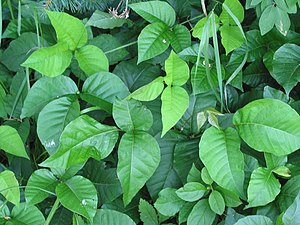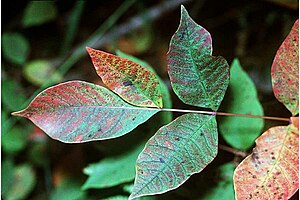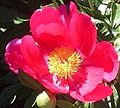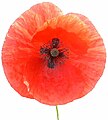Adventist Youth Honors Answer Book/Nature/Flowers
| Flowers | ||
|---|---|---|
| Nature General Conference See also Flowers - Advanced |
Skill Level 2 | 
|
| Year of Introduction: 1928 | ||
Flowers present an exciting field of study to people of all ages. Though young boys may dismiss the study of flowers as something too "girly," they will soon discover that flowering plants are a truly fascinating subject. There are thousands of species of flowering plants all around us. Most have flowers for only a short time, and most are inconspicuous - not what most people would even call a flower, but would be quick to call a weed. If the student of nature is willing to expand the definition of "flower" to include any plant that produces flowers, a whole new world of flowers will be opened.
An example would be a plant known as loosestrife. Loosestrife is not a plant that most gardeners would consider cultivating - it looks very much like a weed. But upon close examination, the careful observer will find much about the plant to take delight in. Some species of loosestrife have yellow flowers, others have purple ones. The flowers themselves are on the smallish side, but they are quite beautiful. They attract bees, ants, and other insects. Being able to identify a "weed" can be very satisfying and requires careful attention to detail. I personally hunt out weeds whenever I am out for a walk - indeed, sometimes finding a new "weed" is the whole point of the walk. When I see one I do not know, I take a careful look. What color is the flower? How many petals does it have? Do the leaves grow from the stem in pairs, opposite one another, or do they take turns, growing alternately? Are the veins in the leaves branched or parallel? Does the leaf grow directly from the stem, or is it attached by a small stem of its own? Is the stem hairy? square? All of these questions are important clues to a plant's identity. When my walk is over, I turn to a field guide or to one of many sites on the Internet and try to identify the plant I have discovered. It is a thrill to me when I finally figure out what it is, and then I read everything I can about this new species in my arsenal. Is it a native plant, or was it introduced? Does it have edible parts? Does it have a medicinal use? What is peculiar about it? Why does it have the name it has? The answers to these questions are almost invariably fascinating! I invite you to study God's world through the flowers He created!
1. Draw or photograph 35 kinds of flowers and identify them correctly.[edit | edit source]
This website http://www.realtimerendering.com/flowers/flowers.html can help you identify flowers by entering in the answers to several questions. It would be a good idea to print out the form and take copies with you into the field. Some of the questions are difficult to answer unless you have the plant right in front of you.
-
Arctotis
-
Aster
-
Azalea
-
Begonia
-
Bladder Campion
-
Bluebell
-
Boneset
-
Carnation
-
Chamomile
-
Chrysanthemum
-
Clematis
-
Columbine
-
Crocus
-
Dahlia
-
Daisy
-
Forget Me Not
-
Forsythia
-
Geranium
-
Hollyhock
-
Hydrangea
-
Hyacinth
-
Lady's Slipper
-
Iris
-
Lantana
-
Lily
-
Lupine
-
Marigold
-
Nasturtium
-
Orchid
-
Pansy
-
Peony
-
Periwinkle
-
Petunia
-
Phlox
-
Poppy
-
Primrose
-
Rose
-
Starflower
-
Sunflower
-
Sweet Pea
-
Tansy
-
Tufted Vetch
-
Tulip
-
Violet
2. Draw and properly label, or point out the actual parts of a flower: pistil, stamen, petal, sepal.[edit | edit source]


.
3. Name six flower families and their distinguishing characteristics. Name at least two flowers in each family.[edit | edit source]
Orchid[edit | edit source]
The Orchid family is the largest family of flowering plants, containing some 25,000 species. Orchids, like the grasses and the palms, which they resemble in some ways—for instance the form of their leaves—are monocotyledons. They have one cotyledon, or embryonic leaf, in contrast to the two of most flowering plants. Orchids have simple leaves with parallel veins. Their shape is highly variable between species.
- Vanilla
- Lady's Slipper
- Orchid
Lily[edit | edit source]
Plants in this family have linear leaves, mostly with parallel veins, and flower parts in threes.
- Turk's Cap Lily
- Wild Garlic
- Onion
- Trillium
- Fawn Lily
- Tulip
- Hyacinth
Mustard[edit | edit source]
The family was formerly named Cruciferae ("cross-bearing"), because the four petals of their flowers are reminiscent of crosses.
- Cabbage
- Broccoli
- Cauliflower
- Brussels sprouts
- Mustard
- Horseradish
- Watercress
Pink[edit | edit source]
The leaves are almost always opposite, rarely whorled. The blades are entire, petiolate and often stipulate. These stipules are not sheathforming. The flowers are regular and mostly have 5-way symmetry, i.e. with 5 petals and 5 sepals, but sometimes with 4 petals. The sepals are free from one another or united. The petals are fringed or deeply cleft at the end.
- Carnation
- Bladder Campion
- Swamp Milkweed
- Common Milkweed
- Butterfly Plant
- Sand Milkweed
- Whorled Milkweed
- Deptford Pink
Buttercup[edit | edit source]
Plants in the Buttercup family are mostly herbaceous plants, but with some woody climbers (such as Clematis) and subshrubs (e.g. Xanthorhiza). Leaves are very often more or less palmately compound. The flowers have many free stamens arranged in a spiral and usually many free pistils. Flowers are most often grouped in terminal racemes, panicles or cymes.
- Delphinium
- Columbine
- Marsh Marigold
- Thimbleweed
- Clematis
- Hellbore
- Larkspur
- Buttercup
Cactus[edit | edit source]
Cacti are distinctive and unusual plants, which are adapted to extremely arid and hot environments, showing a wide range of anatomical and physiological features which conserve water. Their stems have expanded into green succulent structures containing the chlorophyll necessary for life and growth, while the leaves have become the spines for which cacti are so well known.
- Saguaro
- Barrel Cactus
- Prickly Pear
- Rabbit Ear
Rose[edit | edit source]
Members of the Rose family have 5 sepals and 5 petals which are flat and wavy at the margins. Each flower has at least ten stamens. All members of the rose family have a hypanthium, which is a bowl-shaped part of a flower consisting of the bottoms of the sepals, petals, and stamens stuck together.
- Rose
- Apple
- Blackberry
- Strawberry
- Raspberry
- Apple
- Plum
- Peach
- Cherry
- Pear
Bean[edit | edit source]
All members of this family have five-petaled flowers in which the superior ovary ripens to form a "pod", technically called a legume, whose two sides split apart, releasing the seeds which are attached to one or both seams. A significant characteristic of legumes is that they host bacteria in their roots, within structures called root nodules. These bacteria have the ability to take nitrogen gas out of the air and convert it to a form of nitrogen that is usable to the host plant. This process is called nitrogen fixation.
- Bean
- Lupins
- Clover
- Alfalfa
- Peas
- Peanuts
- Soybeans
- Lentils
- Mimosa
- Kudzu
Parsley[edit | edit source]
The parsley family has flower clusters being in the form of a compound "umbel". The small flowers are radially symmetrical with 5 small sepals, 5 petals and 5 stamens.
- Cumin
- Parsley
- Carrot (Queen Anne's Lace)
- Dill
- Caraway
- Fennel
- Angelica
Smartweed[edit | edit source]

The seeds of the plants belonging to the smartweed family have a triangular shape. Leaves of these plants have a peculiar pair of sheathing stipules known as ocreae.
- Buckwheat
- Sorrel
- Rhubarb
- Knotgrass
Bellflower[edit | edit source]
The Bellflower family consists mostly of herbs, shrubs, and more rarely small trees, which usually have milky non-toxic sap. Leaves of these species are often alternate, more rarely opposite. They are also simple and without stipules. Flowers are bisexual, bell-shape, consisting of a narrow tube-like corolla with small spreading lobes. Flowers are fairly often blue. Fruits are often berries, but can also be capsules.
- Bluebell
- Harebell
- Lobelia
- Balloonflower
Mint[edit | edit source]
The flowers in the Mint family typically have petals fused into an upper lip and a lower lip. The leaves emerge oppositely, each pair at right angles to the previous one or whorled. The stems are frequently square in cross section, but this is not found in all members of the family, and is sometimes found in other plant families. The flowers are bilaterally symmetrical with 5 united petals, 5 united sepals. They are usually bisexual and have a flower cluster that looks like a whorl of flowers but actually consists of two crowded clusters.
- Basil
- Mint
- Rosemary
- Sage
- Savory
- Marjoram
- Oregano
- Thyme
- Lavender
- Perilla
- Self-heal
Aster (Daisy)[edit | edit source]


Plants in the Aster family typically have one or both of two kinds of florets. The outer perimeter of a flower head like that of a sunflower is composed of florets possessing a long strap-like petal, termed a ligule; these are the ray florets. The inner portion of the flower head (or disc) is composed of small flowers with tubular corollas; these are the disc florets. The composition of asteraceous inflorescences varies from all ray flowers (like dandelions, genus Taraxacum) to all disc flowers (like pineapple weeds).
- Aster
- Common Daisy
- Oxeye Daisy
- Black-eyed Susan
- Lettuce
- Chicory
- Sunflower
- Safflower
- Jerusalem Artichoke
- Goldenrod
- Chrysanthemum
- Dandelion
- Boneset
- Strawflower
- Ragwort
Snapdragon[edit | edit source]
The plants are annual or perennial herbs with flowers that are zygomorphic (can be divided by only a single plane into two mirror-image halves, much like a person's face), or rarely actinomorphic (can be divided into symmetrical halves by more than one longitudinal plane passing through the axis, much as a pie can be cut into several equal and identical pieces).
- Butterfly Bush
- Figwort
- Foxglove
- Mullein
Internal links[edit | edit source]
Hydroponics for orchid cultivation
Creative Idea: Use a foldable to record / organize this information. Go here http://www.youtube.com/watch?v=b6K0RnlNM7E to learn how.
4. Describe the life history of a particular flower, including the part played by insects or wind in pollination.[edit | edit source]
- A seed needs warmth and water to grow roots.
- The flower sprouts up and down at the same time, send a shoot upwards, and a root downwards.
- The flowers grow more leaves.
- The blossoms open.
- Bees and other insects pollinate the flowers.
- The flowers form seeds.
- The seeds are dispersed and take root.
- The cycle repeats.
5. Name at least two plants that are poisonous to touch, and state which, if any, are found in your locality.[edit | edit source]
 |
 |
 |
 |
Poison Ivy, Poison Oak, and Poison Sumac all fall into this category. Poison ivy grows all over North America, and is most fond of disturbed areas such as stream banks and roadsides. Poison oak grows primarily in Texas, Oklahoma, and the Southeastern and Western United States. Poison Sumac is found in subtropical and warm temperate regions throughout the world, with the highest diversity in southern Africa.
Another plant to watch out for is the wild parsnip (Pastinaca sativa). This plant has an edible tuber, and indeed was cultivated for this for centuries. But if contact with the plant is made with wet (or sweaty) skin, followed by exposure to sunlight, it can cause a purple rash that can last several weeks. In some cases, the discoloration caused by the rash can be permanent.
6. Do three of the following[edit | edit source]
a. Arrange, draw or photograph a series of at least six flowers showing in order the colors of the rainbow: red, orange, yellow, green, blue, violet.[edit | edit source]
It is sometimes difficult to assign a color to a flower. Some varieties of a flower in a given species will have blossoms in one color, while another variety will have them in another. Some flowers are difficult to call blue or violet, as the color lies somewhere in between. Red and violet flowers can also be in between. Use your best judgment to meet this requirement. We present a few possibilities here, so do not feel constrained by this list.
| Red | Orange | Yellow | Green | Blue | Violet |
|---|---|---|---|---|---|
|
|
|
|
|
|
b. Submit fresh, pressed or dried flowers which have: five petals, four petals, three petals, no petals.[edit | edit source]
The following are some possible flowers for your collection.
| Five petals | Four petals | Three petals | Apetalous |
|---|---|---|---|
|
|
|
|
c. Distinguish and name two out of five wild or cultivated flowers by their odor, while blindfolded.[edit | edit source]
This requirement is a fun activity that your Pathfinders are sure to enjoy. Select the flowers carefully, either from your garden (or one you have permission to "raid"), or from a store that sells flowers (a florist or a grocery store). Smell them to be sure they each have a discernible odor, and then determine their identities (you can use a key to do this). Cultivated flowers will generally have a stronger aroma than wild flowers. Allow each Pathfinder to sniff all the flowers without blindfolds so they can learn the smells. When a Pathfinder is ready, apply the blindfold, and hold the flower near the nose. Allow each flower to be sniffed and have the Pathfinder announce its supposed identity. If the Pathfinder cannot get two out of five in the first, try, allow him (or her) to smell them again without the blindfold and be sure the flower can be identified without the blindfold. Then try again.
d. List flowers that you have observed being visited for food by the following[edit | edit source]
- 1. Birds:
- 2. Honeybees:
- 3. Bumblebees:
- 4. Butterflies:
- 5. Moths:
It may be necessary to use a pair of binoculars for this requirement, as birds are highly unlikely to visit any flower a Pathfinder is hovering over. Hummingbirds are the most likely avian visitors you will see visiting a flower for food. Bumblebees can be distinguished from honey bees by their size (bumblebees are two or three times larger).
e. Watch a flower for at least ten minutes in the sunshine, and at least ten minutes after dusk, and report on insect visitors. State the number and kind of visitors and name of flower.[edit | edit source]
This can be an excellent activity for a campout. The post-dusk observations are quite suitable as a vespers activity, and the daytime observations work well during the Sabbath morning services.
Compare this requirement with requirement 7 of the Shrubs honor.
References[edit | edit source]
- Book:Adventist Youth Honors Answer Book/Honors with an Advanced Option
- Book:Adventist Youth Honors Answer Book/Honors
- Book:Adventist Youth Honors Answer Book
- Book:Adventist Youth Honors Answer Book/Skill Level 2
- Book:Adventist Youth Honors Answer Book/Honors Introduced in 1928
- Book:Adventist Youth Honors Answer Book/Nature
- Book:Adventist Youth Honors Answer Book/General Conference
- Book:Adventist Youth Honors Answer Book/Completed Honors











































